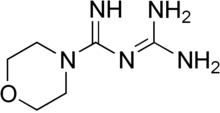Moroxydine is an antiviral drug that was originally developed in the 1950s as an influenza treatment. It has potential applications against a number of RNA and DNA viruses.[1] Structurally moroxydine is a heterocyclic biguanidine.[citation needed]

| |
| Names | |
|---|---|
| IUPAC name
N-(Diaminomethylidene)morpholine-4-carboximidamide
| |
| Other names
Moroxidine
| |
| Identifiers | |
3D model (JSmol)
|
|
| ChemSpider | |
| ECHA InfoCard | 100.020.994 |
| EC Number |
|
| KEGG | |
PubChem CID
|
|
| UNII | |
CompTox Dashboard (EPA)
|
|
| |
| |
| Properties | |
| C6H13N5O | |
| Molar mass | 171.20 g/mol |
| Pharmacology | |
| J05AX01 (WHO) | |
Except where otherwise noted, data are given for materials in their standard state (at 25 °C [77 °F], 100 kPa).
| |
It was reported in March 2014 that three kindergartens in two provinces of China had been found to be secretly dosing their students with moroxydine hydrochloride to try to prevent them from becoming ill. The kindergartens are paid only for the days that pupils attend and wanted to ensure that they maximised their earnings.[2]
References
edit- ^ Sheppard, S. (1994). "Moroxydine: The story of a mislaid antiviral". Acta Dermato-Venereologica. Supplementum. 183: 1–9. PMID 9868507.
- ^ Moore, Malcolm (2014-03-20). "China: All children to be given drug tests after schools caught medicating pupils". The Age. Retrieved 2014-03-20.
Wikispecies has information related to Moroxydine.